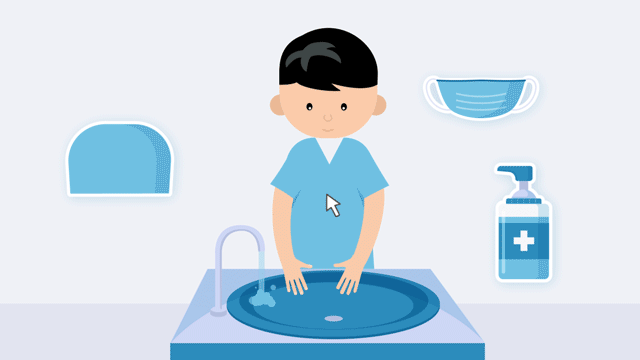You can use many types of training content to develop and enhance the quality of your training. The tricky part is determining which one matches up with your content. Depending on the subject, complexity, and other factors, you can consider using the following types of training content in your courses.
4 Types of Training Materials You Should Look For
#1: Informational e-documents
Although informational e-documents are the most basic type of training materials, they still deserve mention. These e-documents often contain pages with text, images, and “Next” buttons.
This category covers many types of training documents:
- Word documents
- PowerPoint presentations
- PDF e-books
- Etc.
To spice up the materials, you can add visual elements such as:
- Images: The most basic visual accompaniment to a piece of content, images display the material in context. They also add emotional value, making it easier to explain concepts than words alone.
- Screenshots: This format is suitable for software or app training. You can annotate screenshots highlighting features such as tabs, menus, and boxes.
- Illustrations: In some cases, an image will outperform a photograph by emphasizing details directly relevant to the subject. An illustration may name separate parts of an object, describe a process, or show aspects the human eye cannot see.
E-documents are an ideal match for:
- Standardized knowledge or skills for a diverse range of learners
- Manuals, instructions, guidelines, how-to blog posts, procedures, or processes that people may save and refer to later to complete their tasks;
- Data for new service training or policy updates.

#2: Video types
Video is one of the most preferred types of training content. It provides a break for students, especially when placed after a section of text in a course. However, when videos are too long, they can become tiresome.
According to ej4, the ideal length is up to 7 minutes. If your videos are much longer, remove any content unrelated to the learning objective to shorten them. If the videos are too long, consider breaking them up into multiple videos, each with a different type of content, to break up the experience.
Furthermore, videos can help learners learn faster by using visuals and motion. According to studies, the human brain interprets visuals 60,000 times faster than text. Visuals can also send up to 90% of information to the brain.

Some video forms to consider for eLearning courses include:
- Talking-head video: This is a video in which the instructors deliver information by talking directly to the camera. It’s suitable for classes, product demos, instructions, and situation simulation.
- Live-action video: Actual people are filmed in narratives, interviews, live demos, or tutorials. This is often used for topics concerning the use of new software systems or the operation of computer programs.
- Screen-cast video: A recording of your computer’s screen.
- Animation video: Illustrations with moving scenarios. This one covers almost every type of training content
Take this Rheumatic heart disease from the University of Minnesota as an example to see how to simplify training with animated training videos. It includes some animated descriptions to explain the cause of heart diseases.
The lesson contains the same information whether the trainers use documents, presentation slides, or videos. However, with the animated explainer video below, learners can quickly grasp the lesson.
#3: Scenarios-based activities
Whenever possible, allow for practice within the course. Learning just the theory makes it more difficult to remember and recall specifics. Therefore, practice is especially essential for learners who may not be able to put their new skills to use right away.
Scenarios-based activities are another essential type of training material. Just get creative in finding other ways for employees to practice processes and solve problems as part of the course.
Take the video below for examples. Learners must decide how situations will unfold in scenario-based activities. Each case will change as they select solutions from the various options available.
Best suitable for:
- Soft skill training requires real-world practice, such as leadership, decision-making, critical thinking skills, etc.
- Communication skill training for some front-line positions, such as salespersons, customer service staff, telephone agents, or receptionists.
#4: Interactive assessment
It is common practice to include a final test at the end of the course. The test helps to evaluate whether staff members are prepared after training.
This test is often in the form of interactive question types: sequence, true/false, multiple-choice, drag-and-drop, fill-in-the-blank, and so on. Many learners find these quizzes motivating because they can see what the training will teach them and know what to expect.
When learning a ton of information, interactive assessment helps learners remember everything they have learned. You can use interactive assessment to review employees’ learning before moving on to the next point.
To sum up
We hope our step-by-step guide has helped you understand four different types of training materials. Take advantage of these types above when creating your online training course. These types will allow you to present information in a new way and make each of your courses unique.
Read more:
- How to Curate Existing Training Content and Materials for Better Course Development
- How to Organize Training Materials and Training Content
- How to Create Training Content and Materials for Your Employees

Sean Bui, the founder and creative director of F.Learning Studio, is a respected leader in the e-learning and multimedia production industry. With over 10 years of experience, he has dedicated his career to helping organizations create engaging and impactful learning experiences.
Under his leadership, F.Learning Studio has grown into a trusted partner for organizations in the education, healthcare, and corporate training sectors, producing over 2,000 minutes of educational animation.





